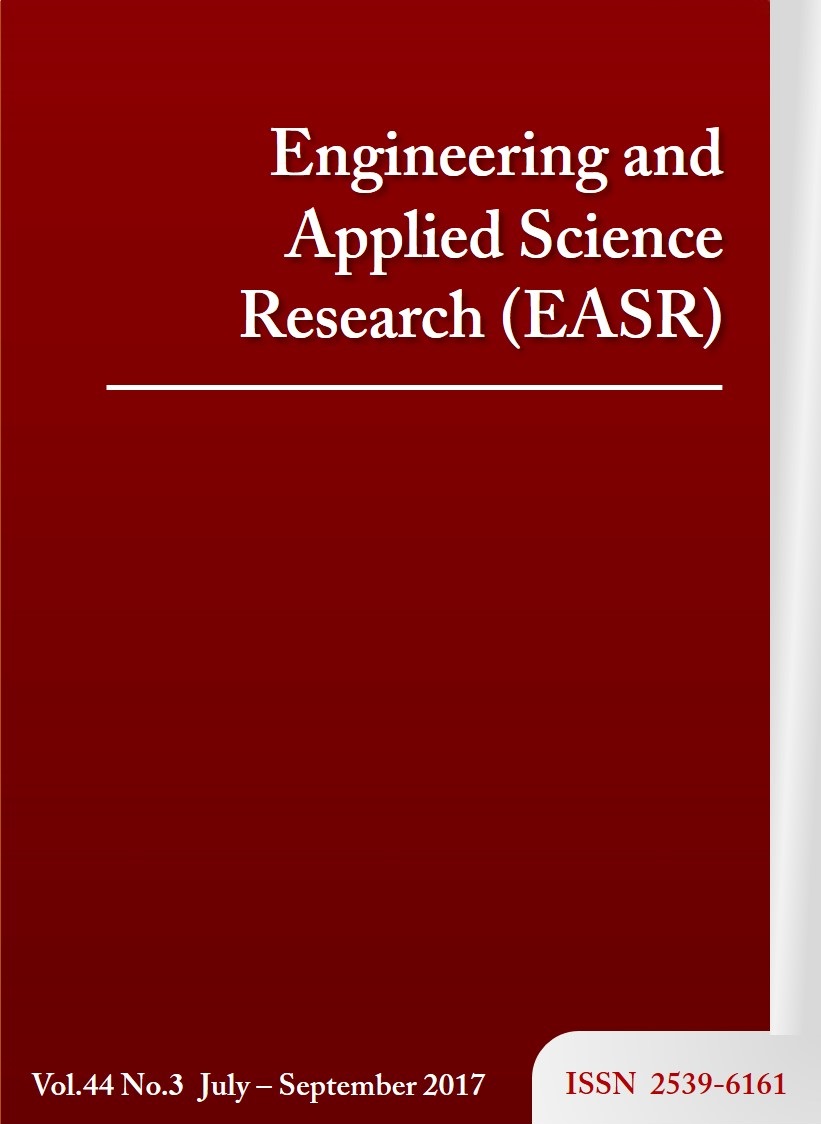Modification of a design storm pattern for urban drainage systems considering the impact of climate change
Main Article Content
Abstract
Inundation of urban areas due to heavy rainfall more frequently occurs in many large cities all over the world. This is more evident now due to the impacts of climate change. The design rainfall storm pattern, an input used to design urban drainage systems, plays an important role for developing sufficient drainage capacity for big cities. There are few studies in Thailand focusing on the accuracy of the Chicago Design Storm, which has been widely used for decades, in estimation of the peak intensity of rainfall for drainage systems. This study aims to first examine the accuracy of the Chicago Design Storm using observed data. Second, the impacts of climate change on rainfall intensity and on the Chicago Design Storm were investigated. Bangkok and its vicinity were selected as study area. Rainfall storm data with 1-5 minutes records and 15 minute records were collected from the meteorological station at AIT over the past 21 years and from the rainfall station in Sukhumvit area of Bangkok for 15 years. The Gumbel distribution was used in a Frequency Analysis to establish IDF Curves. The CDS, Yen & Chow and Sifalda methods were used to synthesize a Design Storm Pattern. Comparison of results of these methods with the observed data revealed that the CDS has good agreement in shape, i.e. peak intensity and time to peak. The CDS is still recommended for use in practice. However, MAPE was also used to evaluate accuracy of the synthesized CDS in comparison with the observed data. It was found that the CDS should be modified to reduce its peak intensity. Moreover, the impact of climate was also investigated. The Equidistance Quantile-Matching Method was adopted to compute IDF curves to include the climate change impact. The Global Climate Model (GCM), and HasGEM2-ES with RCP4.5 were used to generate rainfall data for the next 25 years. The changes in IDF curves due to climate change were compared. With the changed IDF curves, the peak intensity of design storms increased by up to 25%. It is therefore recommended to account for the impacts of climate change on design storms.
Article Details
This work is licensed under a Creative Commons Attribution-NonCommercial-NoDerivatives 4.0 International License.
References
Keifer CJ, Chu HH. Synthetic storm pattern for drainage design. J Hydraul Div. 1957;83(4):1-25.
Bandyopadhyay M. Synthetic storm pattern and runoff for Gauhati, India. J Hydraul Div. 1972;98(5):845-57.
Sifalda V. Entwicklungeines Berechnungsregens für die Bemessung von Kanalnetzen. Gwf-wasser/abwasser. 1973;144(9):435-40.
Desbordes M. (1978). Urban runoff and design storm modelling. In: Helliwell PR, editor. The first International Conference on Urban Storm Drainage; 1978 Apr; Southampton, UK. London: Pentech Press; 1978. p. 353-61
Yen BC, Chow VT. Design hyetographs for small drainage structures. J Hydraul Div. 1980;106(6): 1055-76.
Watt WE, Chow KCA, Hogg WD, Lathem KW. A 1-hour urban design storm for Canada. Can J Civ Eng. 1986;13(3):293-300.
Van Nguyen VT, Peyron N, Rivard G. Rainfall temporal patterns for urban drainage design in southern Quebec. In: Strecker EW, Huber WC, editors. 9th International on Urban Drainage; 2002 Sep 8-13; Oregon, USA. USA: ASCE. p. 1-16.
Water Development Consultants Co., Ltd. Project for investigate and design drainage systems in Sukhumvit sub-catchments area in Bangkok. Bangkok: Department of Drainage and Sewerage; 1998.
Charoensukrungruang W. Analysis of rainfall pattern for urban drainage design [Thesis]. Pathumthani: Asian Institute of Technology; 2006.
Rehan MM. Analysis of rainfall pattern and validation of design storm shape for Asian monsoon [Thesis]. Pathumthani: Asian Institute of Technology; 2016.
Shrestha A. Impact of climate change on urban flooding in Sukumvit area of Bangkok [Thesis]. Pathumthani: Asian Institute of Technology; 2013.
Asayama Y. Flood Risk Reduction Measures in Japan. Myanmar World Water Day; 2017 Mar 13-14; Naypyidaw, Myanmar. Myanmar: National Water Resources; 2017.
Chaowiwat W, Charoensuk T, Weesakul S, Boonya-Aroonnet S. Development of intensity, duration and frequency curve for climate change adaptation in Thailand. The 20th National Convention in Civil Engineering; 2015 Jul 8-10; Chonburi, Thailand. Khon Kaen: Department of Civil Engineering, Faculty of Engineering, Khon Kaen University; 2015.



